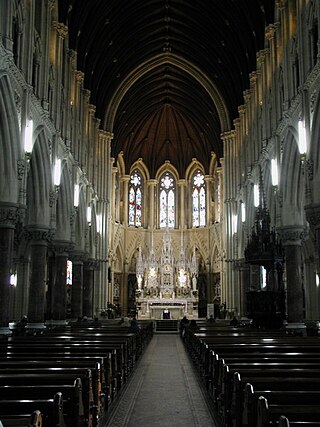
Edgeworth Lysaght, later Edward Anthony Edgeworth Lysaght, and from 1920 Edward MacLysaght, was a genealogist of twentieth century Ireland. His numerous books on Irish surnames built upon the work of Rev. Patrick Woulfe's Irish Names and Surnames (1923).

Cobh, known from 1849 until 1920 as Queenstown, is a seaport town on the south coast of County Cork, Ireland. With a population of 14,418 inhabitants at the 2022 census, Cobh is on the south side of Great Island in Cork Harbour and home to Ireland's only dedicated cruise terminal. Tourism in the area draws on the maritime and emigration legacy of the town.

Kenmare is a small town in the south of County Kerry, Ireland. The name Kenmare is the anglicised form of Ceann Mara, meaning "head of the sea", referring to the head of Kenmare Bay.

Páirc Uí Chaoimh is a Gaelic games stadium in Cork, Ireland. It is the home of Cork GAA. The venue, often referred to simply as The Park, is located in Ballintemple and is built near to the site of the original Cork Athletic Grounds. The stadium opened in 1976 and underwent a significant two-year redevelopment before reopening in 2017.

Daniel Desmond Sheehan, usually known as D. D. Sheehan was an Irish nationalist, politician, labour leader, journalist, barrister and author. He served as Member of Parliament (MP) in the House of Commons of the United Kingdom of Great Britain and Ireland representing Mid-Cork from 1901 to 1918, a constituency comprising the districts of Ahadallane, Ballincollig, Ballyvourney, Blarney, Coachford, Farran, Inchigeelagh, Macroom, Millstreet and Shandangan. As co-founder and President of the Irish Land and Labour Association, he was credited with considerable success in land reform, labour reforms and in rural state housing. From 1909, he was General Secretary of the Central Executive of the All-for-Ireland League, favouring a policy of National reconciliation between all creeds and classes in Ireland. During World War I he served as Irish regiments officer with the 16th (Irish) Division in France, 1915–16. He resigned his parliamentary seat in 1918 and lived in England for several years, returning to Dublin following the ending of the civil war, when he was appointed editor of the Dublin Chronicle.
Royal Cork Institution was an Irish cultural institution in the city of Cork from 1803 to 1885. It consisted of a library of scientific works, a museum with old Irish manuscripts and stones with ogham inscriptions, and lecture and reading rooms. A lack of funds resulted in its closure in 1885.

Cork is the second largest city in the Republic of Ireland, third largest on the island of Ireland, and largest in the province of Munster. At the 2022 census, it had a population of 222,526.
John Walsh was a prominent Irish businessman, and a nationalist politician of the All-for-Ireland League. He was Member of Parliament (MP) for County Cork South from 1910 until 1918, taking his seat in the House of Commons of what was then the United Kingdom of Great Britain and Ireland.
Events from the year 1792 in Ireland.
John Barrett was an Irish hurler, selector and administrator. His career included All-Ireland Championship victories as a player and later as a selector with the Cork senior hurling team.
Richard Henrik Beamish was an Irish politician, brewer and company director.
David McCarthy is an Irish former Gaelic footballer. At club level he played with Clonakilty and University College Dublin and was also a member of the Cork senior football team.
Fermoy GAA is a Gaelic Athletic Association based in the town of Fermoy, Cork, Ireland. The club fields teams in competitions organized by the Cork GAA county board and the Avondhu GAA divisional board. The club plays both Gaelic football and hurling.

The Diocese of Cloyne is a Roman Catholic diocese in Ireland. It is one of six suffragan dioceses in the ecclesiastical province of Cashel.
North Ludlow Beamish, was an Irish military writer and antiquary.

Richard Beamish Cricket Grounds are a cricket ground in the Mardyke, Cork, Ireland. The cricket field and facilities are located on the southern bank of the River Lee, and overlooked by University College Cork and St Vincent's Catholic Church. The ground is officially named after Richard Beamish, but it is generally called The Mardyke after the area where it is situated, or the Cricket Club as it is the home ground of Cork County Cricket Club. The Munster representative provincial side, the Munster Reds, also use The Mardyke as their home ground.

The Spit Bank Lighthouse close to Cobh in County Cork, Ireland is a screw-pile lighthouse which marks a shallow bank in the navigable channels of lower Cork Harbour. The platform was built by the blind Irish engineer Alexander Mitchell, with the lighthouse itself designed by George Halpin. In use since its completion between 1851 and 1853, and renovated as recently as 2013, the landmark structure marks the boundary of compulsory pilotage for large vessels entering the Port of Cork.
Thomas Joseph Byrne was an English architect, and was principal architect to the Office of Public Works in Ireland who oversaw the restoration of a large number of public buildings in Dublin following the Easter Rising, the Irish War of Independence and the Irish Civil War.
The Munster Agricultural Society, also known as the MAS, is a non-profit agricultural organisation headquartered in County Cork, Ireland. Founded in 1805, its stated charitable purpose is “to encourage and promote Agricultural, Industrial, Educational and Scientific Pursuits.” It also oversees the Munster Dairy School and Agricultural Institute.
William Horatio Crawford (1815–1888) was an Irish brewer and philanthropist. He was both a book collector and art collector, and contributed to the art school at the Cork School of Design, which became known as the Crawford School of Art in 1885. Much of the Crawford art collection is now held in the Crawford Art Gallery in Cork city.








